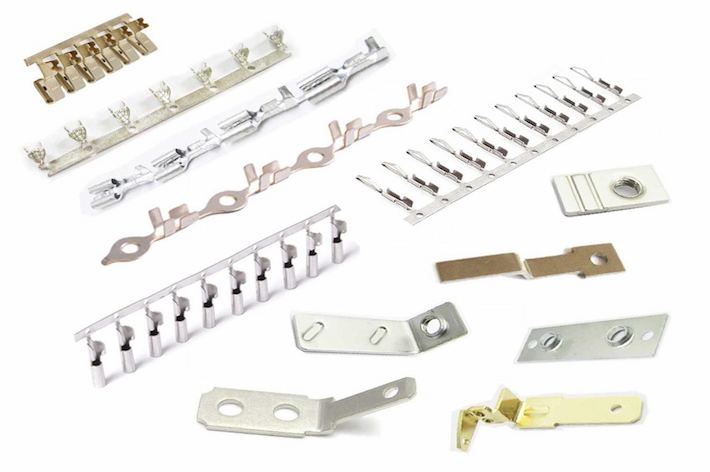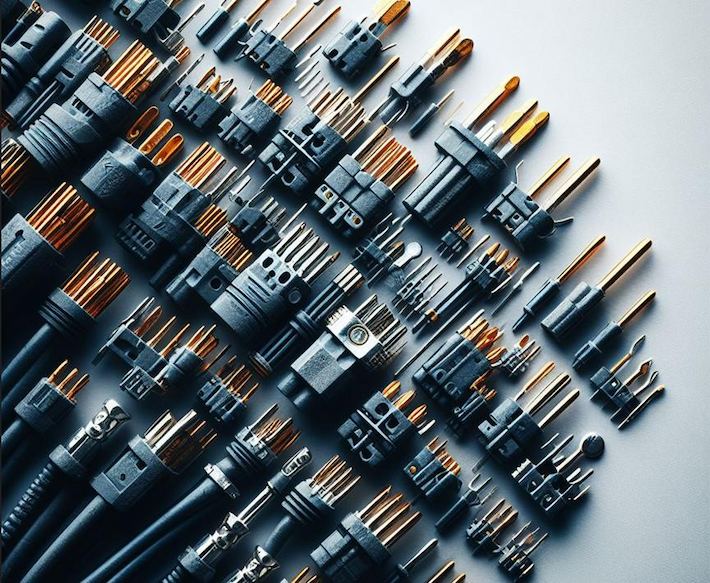
Mecanizado:Los procesos de mecanizado, como el torneado, el fresado y la perforación, se utilizan comúnmente para producir pasadores, varillas y ejes de terminales. El mecanizado permite la conformación precisa y el dimensionamiento de los componentes. Es adecuado tanto para producción a pequeña escala como para mayores cantidades.
Cabezal frío:El encabezado en frío es un proceso que se utiliza para formar la cabeza y el cuerpo de pasadores, varillas y ejes a partir de alambres metálicos o varillas. El proceso implica el uso de troqueles y punzones para deformar el material en la forma deseada. La formación en frío a menudo se emplea para la producción de alto volumen debido a su eficiencia y rentabilidad.
Extrusión:La extrusión es un proceso de fabricación en el que una palanquilla de metal calentada se fuerza a través de una matriz para producir un perfil continuo con una sección transversal consistente. Se usa comúnmente para producir varillas o ejes largos con un diámetro constante o una forma de sección transversal específica.
Estampado:El estampado es un proceso que implica el uso de una prensa de estampado y troqueles para cortar y dar forma a las láminas de metal en la forma deseada. Se usa comúnmente para producir pasadores terminales más pequeños o componentes de forma plana.
Estos son solo algunos ejemplos de procesos de fabricación para pasadores, varillas y ejes de terminales. La elección específica del proceso de fabricación dependerá de los requisitos y restricciones de la aplicación.
Material | Hierro, acero inoxidable, latón, cobre, acero galvanizado, titanio, aluminio, etc. |
Tratamiento superficial | Zinc/níquel/estaño/Ag-chapado/Au-chapado, etc. |
Tipo | Piezas no estándar de alta precisión (Servicio OEM) |
Proceso | Estampado/punzonado/prensado, mecanizado CNC/torneado/fresado, dibujo profundo y otros procesos. |
Certificado | IATF16949 2016;I SO9001 2015; ISO14001:2015;RoHS & REACH, etc. |
Uso | Termostato de automoción/coche, interruptor, calefacción eléctrica, aeroespacial, nueva energía, etc. |
Acero inoxidable: acero inoxidable es una opción popular para pasadores El, varillas y ejes de terminales debido a su excelente resistencia a la corrosión, alta resistencia y durabilidad. Se usa comúnmente en aplicaciones donde el componente necesita soportar condiciones ambientales adversas o requerir buenas propiedades de higiene.
Latón: El latón es otro material ampliamente utilizado para pasadores, varillas y ejes terminales. Ofrece buena conductividad eléctrica, resistencia moderada y resistencia a la corrosión. El latón se elige a menudo para aplicaciones donde la conductividad eléctrica es crucial, como conectores y terminales eléctricos.
Aluminio: El aluminio es un material ligero que se usa comúnmente en aplicaciones donde la reducción de peso es importante. Ofrece buena conductividad eléctrica y resistencia moderada, pero tiene una menor resistencia a la corrosión en comparación con el acero inoxidable o el latón. Los pasadores y ejes de terminales de aluminio encuentran aplicaciones en industrias como la aeroespacial y la automotriz.
Cobre: El cobre es un excelente conductor de electricidad, por lo que es adecuado para aplicaciones que requieren alta conductividad eléctrica. A menudo se utiliza en conectores y terminales eléctricos. Sin embargo, el cobre es relativamente blando en comparación con otros materiales, por lo que puede requerir procesos adicionales de endurecimiento o recubrimiento para mejorar sus propiedades mecánicas.
Los Pines de terminales, aunque de tamaño pequeño, desempeñan un papel fundamental para garantizar una conectividad perfecta y una funcionalidad confiable. Estos componentes sin pretensiones sirven como eslabones cruciales en la cadena de dispositivos electrónicos y eléctricos, facilitando la transferencia de señales y energía. En este artículo, exploraremos los roles multifacéticos que cumplen los pines de terminal en varias aplicaciones.

1. Conexiones de puente:
Los pines terminales actúan como conectores, cerrando la brecha entre los dispositivos electrónicos. Establecen conexiones eléctricas entre diferentes componentes, permitiendo el flujo de señales y energía, ya sea en electrónica de consumo, sistemas automotrices o equipos industriales.
2. conductividad y flujo actual:
Una de las funciones principales de los pasadores terminales es proporcionar un camino conductor para la corriente eléctrica. Fabricados con materiales como latón, cobre o aleaciones, estos pasadores garantizan un flujo de electricidad eficiente y de baja resistencia, minimizando la pérdida de energía.
3. Fijación segura:
Los pasadores terminales están diseñados para una fijación segura dentro de los conectores. Sus dimensiones y formas precisas les permiten adaptarse perfectamente, evitando conexiones sueltas o interrupciones en la continuidad eléctrica, incluso en entornos exigentes.
4. aplicaciones versátiles:
Los Pines de terminal encuentran aplicaciones en diversas industrias, desde telecomunicaciones hasta dispositivos médicos. Son componentes integrales en el ensamblaje de placas de circuitos, arneses de cableado y varios sistemas electrónicos, que muestran su versatilidad.
5. Transmisión de la señal:
En los dispositivos electrónicos, los pines de terminales juegan un papel crucial en la transmisión de señales entre diferentes componentes. Esto es vital para el buen funcionamiento de dispositivos como computadoras, sistemas de comunicación y equipos de audio.
6. conectividad automotriz:
En la industria automotriz, los pasadores de terminales son esenciales para los arneses y conectores de cableado, lo que garantiza conexiones confiables para la multitud de sistemas electrónicos dentro de los vehículos modernos, incluidos sensores, luces y módulos de control.
7. Equipo Médico IntegratiEn:
Los pasadores terminales contribuyen a la integración precisa y confiable de componentes en dispositivos médicos. Su papel en los equipos médicos, como las máquinas de diagnóstico y los dispositivos de monitoreo de pacientes, es fundamental para la transmisión precisa de datos.
8. personalización para aplicaciones específicas:
Como fabricante líder de pines de terminales, HHC Precision ofrece servicios de personalización para cumplir con los requisitos únicos de diferentes industrias. Nuestros pasadores de terminales se pueden adaptar en tamaño, forma y composición del material, lo que garantiza que sean perfectamente adecuados para aplicaciones específicas. Este nivel de personalización nos permite aportar soluciones que satisfagan las necesidades precisas de nuestra diversa clientela.
Los conectores de terminales PIN son componentes electrónicos con aplicaciones versátiles, especialmente en campos que exigen conexiones confiables y alto rendimiento.

Sistemas eléctricos automotrices:
Los conectores de terminales pin juegan un papel crucial en la industria automotriz, facilitando la conexión y transmisión de señales eléctricas. En los sistemas eléctricos automotrices, estos conectores se utilizan comúnmente para conectar sensores, luces, módulos de control y otros componentes electrónicos. Debido a las altas demandas de confiabilidad y rendimiento en los sistemas eléctricos automotrices, los conectores de terminales de clavija proporcionan conexiones eléctricas estables, lo que garantiza el buen funcionamiento de varios sistemas.
Nuevos sistemas de batería de energía:
Los conectores de terminales PIN son componentes clave en los nuevos sistemas de baterías de energía, Módulos de batería de conexión, motores eléctricos y unidades de control de energía. Estos conectores deben soportar altas corrientes y temperaturas al tiempo que garantizan una transferencia de energía eficiente. Con su diseño preciso y conductividad superior, los conectores de terminales de PIN contribuyen a conexiones confiables en vehículos eléctricos y sistemas de energía renovable.
Aplicaciones de Dispositivos Médicos:
En el campo de los dispositivos médicos, los conectores de terminales de PIN se utilizan ampliamente para conectar varios sensores, dispositivos de monitoreo y equipos terapéuticos. La precisión y fiabilidad de estos conectores son cruciales para garantizar el funcionamiento normal de los dispositivos médicos. Proporcionan conexiones eléctricas seguras y estables, lo que facilita la transmisión precisa de datos médicos y contribuye a un diagnóstico y tratamiento precisos para los pacientes.
Sistemas aeroespaciales:
Los conectores de terminales pin encuentran amplias aplicaciones en la industria aeroespacial, conectando y apoyando los sistemas electrónicos y eléctricos de varios aviones. Debido a los requisitos de peso ligero, alta durabilidad y resistencia a altas temperaturas en sistemas aeroespaciales, los conectores de terminales de pines suelen emplear materiales y diseños avanzados para garantizar la confiabilidad en condiciones extremas. Estos conectores se utilizan para vincular sistemas de navegación, equipos de comunicación, sistemas de control de vuelo y más, desempeñando un papel vital en el rendimiento general de la industria aeroespacial
Los pasadores terminales sirven como conectores, lo que facilita las conexiones eléctricas al proporcionar una vía conductora entre los componentes electrónicos. Estos pines están diseñados con precisión para garantizar un ajuste seguro dentro de los conectores, estableciendo enlaces confiables para el flujo de señales y energía. El principio gira en torno a su capacidad para conectar conexiones, permitir un flujo de corriente eficiente y mantener una sujeción segura, lo que garantiza una funcionalidad óptima en diversas aplicaciones como automóviles, electrónica y dispositivos médicos.



